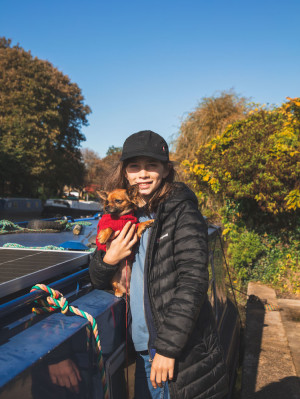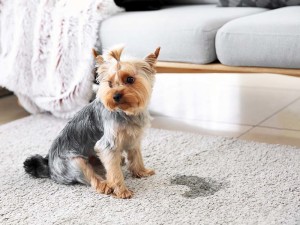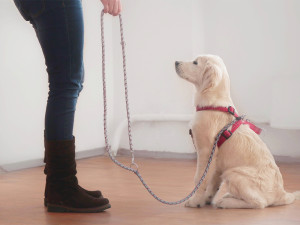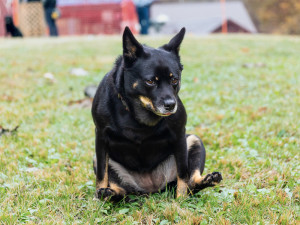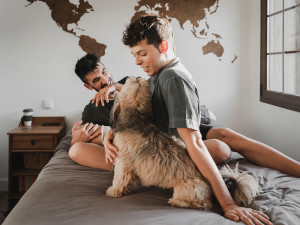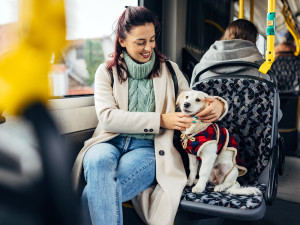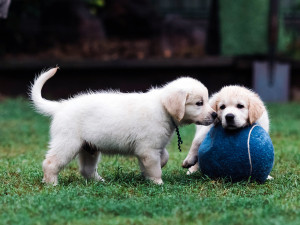How to Toilet Train a Puppy in a Flat With No Outdoor Space
Just ’letting them out in the garden’ isn't an option for everyone, especially in this economy
When I became a puppy owner almost two years ago, I knew toilet training would be challenging, but I didn’t realise I’d be hampered by the outdated information online. Most toilet training guides assumed the owner had a home with a garden (in this economy?) and they could just ‘leave the back door open for the dog’. This made me feel like the worst human in the world for daring to raise a pup in a rented flat without access to a private patch of grass to call our own.
But it’s entirely possible to toilet train a dog in a flat. As long as you can get them up and down the stairs multiple times a day and their physical and emotional needs are met, the square footage of your living space shouldn’t matter. And if you’re worried about cost, you don’t need a lot of equipment to get started, although you may need to invest in some cleaning products because, well, shit happens.
We spoke to Caroline Wilkinsonopens in new tab, a Certified Animal Behaviourist and the founder of digital pet coaching service Barket Placeopens in new tab, to get the lowdown on toilet training your puppy in a flat, something she has personal and professional experience with.
What equipment do I need to buy to toilet train my puppy in a flat?
Caroline says you don’t need to splash out on fancy equipment if you’re on a budget. “On my ‘puppy housetraining’ shopping list for a young dog raised in a flat would be a clicker and lots of yummy high-value treats. The click marks the moment your dog has done something correctly and the sound is always followed by reinforcement – usually a treat. It’s also a good idea to have a pet-specific enzyme cleaner or some biological washing powder ready for accidents.”
If you have a balcony – a dog litter box lined with grass or a ‘porch potty’ may also help with training, but this is not essential.
How often should you take your puppy to the toilet?
If you’re wondering how often you should go outside with your pup, Caroline says the main rule of thumb for puppies is that their bladders can last about an hour per month.
Your puppy should go outside to the toilet:
after eating
after having a big drink
after playtime
after training
when waking up after a nap
If that sounds like a lot – it is! But consistency is key. Try to take them out to the same place to toilet each time at first. Do not nag or distract your dog; just let them get on with it and give them praise and attention when they’ve eliminated. Yes, you may initially feel awkward congratulating every drop of wee or pile of poo but believe me, it works.
Overnight, your dog should last longer as there are fewer stimulating activities. But for at least a few weeks, be prepared that some puppies must go to the toilet overnight.
What mistakes do people make toilet training their dog in a flat?
Caroline says that pet parents’ biggest mistake when house training their dogs is to use punishment if they have any accidents indoors. “Puppies don’t come pre-loaded with instructions on how to act appropriately in our homes. Avoiding any punishment – from telling your dog off if they have an accident to rubbing their nose in it or putting them straight into a crate – can make the toilet-training journey even harder on everyone.”
As tempting as it is to use puppy pads – especially if you are renting a flat and worried about potentially ruining someone else’s furnishings – these can slow the housetraining journey down. As Caroline says, “Puppy pads are an invitation to toilet indoors, can keep the smell of urine in your home, and don’t always mean ‘pee on the mat’ to your dog – they may end up with your dog just peeing on any floor covering.”
What if you’re at the top of a block of flats with no lift?
In the early days, you will need to carry your puppy up and down the stairs to the toilet – as repetitive climbing can be detrimental to their physical development. If you need to do this almost hourly for weeks on end, that can take its toll. “If you’re looking at getting a Great Dane puppy – perhaps a slightly smaller breed may be better if your building has no lift,” says Caroline.
While puppy pads may be a way to avoid repeatedly running up and down stairs, they may delay the time it takes to housetrain and confuse your pup about the correct place to go to the toilet.
If you are lucky enough to have a balcony to place some fake or natural grass, you may want to be mindful of your neighbours. As Caroline points out, “If your dog is starting to cock their leg or there isn’t a good collection tray underneath, your downstairs neighbours might get their balcony ‘watered’, too!”
How do I know when my dog is toilet trained?
It’s hard to know what the ‘endpoint’ looks like when you’re in the puppy toilet training trenches. “Ideally, as a pet parent, you��’ll want to have a dog whose bladder has matured to last multiple hours between toilet breaks – ideally, three to four hours during the day and eight hours overnight,” says Caroline.
“You may have other training aims, such as training your dog to tap at your door or bark in a specific way to let you know they need a pee break. However, not all dogs do this naturally, so you may need to teach them to paw-target a bell to ring when they need to go out. Alternatively, you can create a routine that works for your dog in terms of frequent trips out to alleviate themselves.”
How do you deal with accidents once training is ‘done’?
Like humans, dogs can get upset stomachs and urine infections. However, “If your dog suddenly needs to go to the toilet more frequently, get them checked by your vet ASAP,” advises Caroline. “When female dogs are in season, they may need to urinate more frequently, so increasing toilet trips outside is only fair. While your male adolescent dogs might need to wee on anything and everything while out on a walk, this shouldn’t increase their desire to toilet in your home.”
As with initial housetraining, the way forwards is to deal with accidents without punishment and clean up with minimal fuss.
What are the best cleaning products for dog toilet training?
Caroline recommends diluting some biological washing powder to clean up any accidents that might occur. White vinegar and bicarbonate of soda are also great options for their odour-neutralising properties. The key to cleaning up accidents is making the process as fuss-free as possible. “If you make too much of a song-and-dance about it, your dog might either get scared to toilet near you (definitely something we want to avoid), or they might think that chasing the paper towel or mop is a fun game!”



